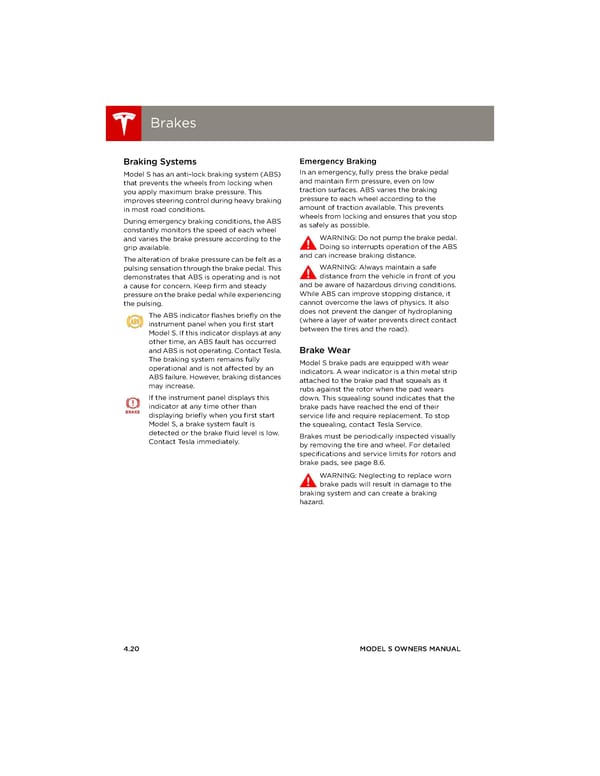book.book Page 20 Friday, July 19, 2013 12:53 PM Brakes Brakes Brakes Emergency Braking Braking Systems Model S has an anti-lock braking system (ABS) In an emergency, fully press the brake pedal that prevents the wheels from locking when and maintain firm pressure, even on low you apply maximum brake pressure. This traction surfaces. ABS varies the braking improves steering control during heavy braking pressure to each wheel according to the in most road conditions. amount of traction available. This prevents During emergency braking conditions, the ABS wheels from locking and ensures that you stop constantly monitors the speed of each wheel as safely as possible. and varies the brake pressure according to the WARNING: Do not pump the brake pedal. grip available. Doing so interrupts operation of the ABS The alteration of brake pressure can be felt as a and can increase braking distance. pulsing sensation through the brake pedal. This WARNING: Always maintain a safe demonstrates that ABS is operating and is not distance from the vehicle in front of you a cause for concern. Keep firm and steady and be aware of hazardous driving conditions. pressure on the brake pedal while experiencing While ABS can improve stopping distance, it the pulsing. cannot overcome the laws of physics. It also The ABS indicator flashes briefly on the does not prevent the danger of hydroplaning instrument panel when you first start (where a layer of water prevents direct contact ModelS. If this indicator displays at any between the tires and the road). other time, an ABS fault has occurred and ABS is not operating. Contact Tesla. Brake Wear The braking system remains fully Model S brake pads are equipped with wear operational and is not affected by an indicators. A wear indicator is a thin metal strip ABS failure. However, braking distances attached to the brake pad that squeals as it may increase. rubs against the rotor when the pad wears If the instrument panel displays this down. This squealing sound indicates that the indicator at any time other than brake pads have reached the end of their displaying briefly when you first start service life and require replacement. To stop Model S, a brake system fault is the squealing, contact Tesla Service. detected or the brake fluid level is low. Brakes must be periodically inspected visually Contact Tesla immediately. by removing the tire and wheel. For detailed specifications and service limits for rotors and brake pads, see page 8.6. WARNING: Neglecting to replace worn brake pads will result in damage to the braking system and can create a braking hazard. 4.20 MODEL S OWNERS MANUAL
 Tesla Model S | Owner's Manual Page 59 Page 61
Tesla Model S | Owner's Manual Page 59 Page 61